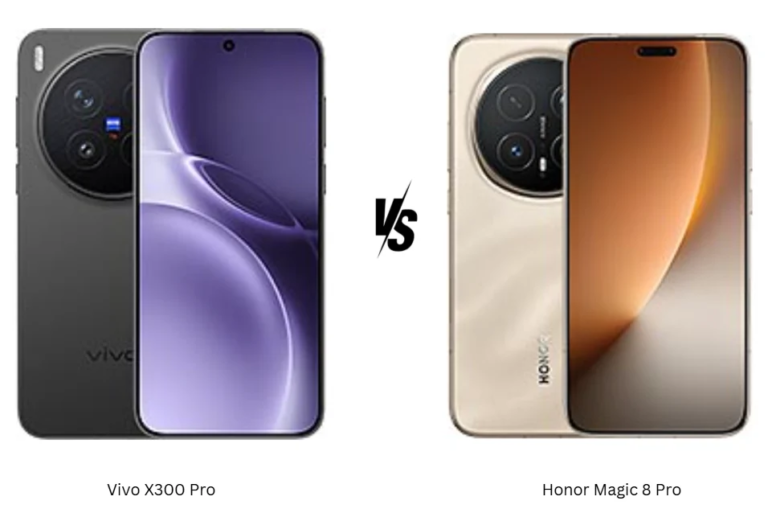1. Design and Display
Build and Feel
Both smartphones present a premium flagship identity, but they do so with different design philosophies. The Vivo X300 Pro leans into a more luxurious, glass-heavy approach supported by an aluminum alloy frame, giving it a refined, high-end aesthetic. Honor Magic 8 Pro opts for durability with Giant Rhino Glass on the front and a reinforced plastic back, delivering a more rugged but still modern look. The IP68/IP69 ratings on both devices ensure strong protection, but Honor’s IP69K rating adds a slight edge for extreme water-jet resistance. Overall, Vivo’s design feels more sophisticated, while Honor prioritizes toughness.
Display Quality
Vivo offers an LTPO AMOLED panel with rich color depth, HDR certifications, and extremely high peak brightness. Honor counters with an LTPO OLED display featuring a remarkably high PWM rate that benefits users sensitive to flicker. Honor’s peak brightness is also impressive, making outdoor visibility excellent. Vivo’s display feels more cinematic, while Honor delivers technical advantages suited for long-term viewing comfort.
Verdict
Honor has the more versatile and eye-comfort-focused display, while Vivo delivers a more polished and visually immersive experience. Design preference depends on whether luxury (Vivo) or durability (Honor) matters more.
2. Specifications
Performance
The Vivo X300 Pro is powered by MediaTek’s Dimensity 9500, a strong and efficient flagship-class chip ideal for performance stability. Its CPU and GPU combination is tuned for consistent thermal behavior, which helps during extended gaming and multitasking. Honor Magic 8 Pro steps ahead with the Snapdragon 8 Elite Gen 5, bringing higher clock speeds, stronger graphics, and future-ready on-device AI performance. Honor’s overall processing package feels more elite and better suited for demanding workflows or long-term performance gains.
Battery and Charging
Honor has a larger battery capacity globally and supports extremely fast wired and wireless charging, especially in its Chinese variant. Vivo still offers strong endurance with its Si/C battery and meaningful fast charging options, but Honor’s charging configuration is simply more aggressive and versatile. Users who rely on frequent top-ups or heavy screen time will find Honor’s battery system more accommodating.
Verdict
Honor Magic 8 Pro clearly leads in raw performance and charging flexibility, while Vivo maintains dependable stability and efficiency best suited for consistent daily use.
3. Camera
Main and Secondary Lenses
Both phones use a similar triple-camera approach with high-resolution primary and periscope telephoto lenses, but their tuning philosophies differ. Vivo’s camera system is heavily influenced by ZEISS optics, giving its images a more natural tone and film-like contrast that appeals to photography-focused users. The 200MP periscope lens offers macro capability, adding creative versatility. Honor’s setup also includes a 200MP periscope module with strong OIS and a wide field of view, tuned for higher clarity and brighter exposures. Its ultrawide lens provides a slightly broader perspective. Honor’s performance feels more computationally advanced, while Vivo feels more artistic.
Selfie Camera
Vivo’s 50MP AF selfie camera focuses on sharpness and detail with natural color accuracy, making it excellent for portrait-style selfies. Honor adds a 3D TOF sensor for secure face authentication and enhanced depth mapping, giving it a more feature-rich front-camera system. Honor’s selfies feel more software-driven, while Vivo leans on optical purity.
Verdict
Vivo appeals more to photography enthusiasts who value color science and ZEISS tuning. Honor excels in versatility, computational strength, and added front-camera features.
4. Pricing
Honor Magic 8 Pro starts around $850, while the Vivo X300 Pro is slightly more affordable at approximately $800. The difference is small, but it positions Vivo as the more value-oriented option for users wanting strong cameras, premium build quality, and reliable performance without stretching the budget. Honor, on the other hand, justifies its higher price through superior processing power, faster charging technologies, and extended software support with up to seven major Android upgrades, an advantage rare in the Android ecosystem. The price gap can feel negligible considering the upgrades Honor delivers, especially for long-term buyers.
Verdict
Vivo offers better value on paper, but Honor provides more longevity and raw performance per dollar. Users deciding based strictly on price will lean toward Vivo, while those prioritizing extended software support and high-end power will find Honor worth the extra cost.
Disclaimer:
Prices are approximate and may vary based on country, region, and applicable taxes.
5. Conclusion
Vivo X300 Pro’s strengths lie in its ZEISS-backed camera system, refined design, dependable performance tuning, and a display that feels cinematic. It caters to users who want consistent quality across photography, build, and daily usability.
Honor Magic 8 Pro pushes harder with next-gen processing, extended software updates, advanced charging speeds, and additional technologies such as a TOF sensor and optional satellite features in certain regions. Its display’s ultra-high PWM dimming also makes it a great choice for users sensitive to eye strain.
Each phone offers a unique identity: Vivo focuses on elegance and optical authenticity, while Honor prioritizes raw power and future-proofing.
Verdict
Choose Vivo X300 Pro if premium design, natural photography output, and a balanced feature set matter most. Pick the Honor Magic 8 Pro for performance-heavy workloads, superior battery charging, and long-term software value. Both are excellent flagships, but their priorities cater to different types of power users.
Read More:



